Andrew Nicholl, Landscape Painter in Water-colour
(b. 1804, d. 1886)
Landscape Painter in Water-colour
From A Dictionary of Irish Artists 1913

Andrew Nicholl, R.H.A. Picture, by F. Piccione; in possession of Dr. Elliott, Rostrevor.
Was born in Church Lane, Belfast, on 4th April, 1804, the son of a boot-maker. He was apprenticed to H. D. Finlay, the Belfast printer, and when the latter started the "Northern Whig" worked for several years as a compositor on that paper. From his boyhood he was devoted to art, and won a reputation as a landscape painter in his native town. Going to London he continued his studies there. His favourite resort was the Dulwich Gallery, where he made copies of many of the pictures. Leaving London he settled for some time in Dublin; he made his first contribution to the Royal Hibernian Academy in 1832, and was elected an Associate on the 27th May, 1837. On the enlargement of the membership under the new charter in 1860 he became a full member. On the death of Henry Brocas (q.v.) in 1837 the Fine Art Committee of the Royal Dublin Society selected Nicholl as the most suitable candidate for the vacant post of Master in the drawing school; but the choice was over-ruled, and the Society elected Henry Brocas, jun. In 1840 he had taken up his residence in London, but he continued to contribute to the exhibitions at the Royal Hibernian Academy. He exhibited in London, at the Royal Academy, between 1832 and 1854, and at other exhibitions down to 1867. In 1849 he was sent out by Government to Ceylon as teacher of painting and drawing at the Colombo Academy. There he found a staunch friend in the Colonial Secretary, Sir James Emerson Tennent, a native of Belfast, by whom he was engaged to make drawings of scenery in Ceylon.
Returning to Europe he resided for a time in London, and then in Dublin, and afterwards went to Belfast, where he was engaged in teaching landscape drawing. He finally returned to London and died at No. 7 Camberwell Grove, on 16th April, 1886, aged 82. Nicholl contributed a number of views to the "Dublin Penny Journal," from its first number in July, 1832; and illustrations, about 109 in number, to Hall's "Ireland, its Scenery and Character." Other engraved works after his drawings are: "The Northern Coast of Ireland," a series of twelve lithographs, published by himself at 27 College Street, Belfast, and by Ackermann, London; thirteen coloured "Views of the Dublin and Kingstown Railway," engraved by Robert Clayton and published in Dublin in 1835; "Dunluce Castle," aquatint by J. Gleadah, published by Nicholl in London in 1830. In the British Museum are: "The Giant's Causeway" and "Rathlin Island, Doon Point," both in water-colour, and two views in Ceylon in pencil. Several of his drawings were purchased by Queen Victoria in 1858 and 1870; a number are in the possession of Dr. Elliott of Rostrevor, and six are in the Victoria and Albert Museum.
He contributed articles and poetry to various periodicals, including the "Dublin University Magazine," in which appeared in 1852 "A Sketching Tour of five weeks in the Forests of Ceylon."
Nicholl had an only child, a daughter, Mary Anne, who was a good artist in pen and ink, and exhibited in the Royal Hibernian Academy. In 1889 she presented to the Academy a number of her father's drawings done in Ceylon.
